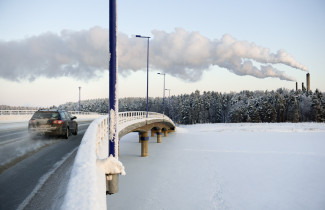Car owners have to think about the emissions of their car at least when they take it to vehicle inspection for an emissions test. How much is my car polluting?
- Text Marianne Mustonen
- Photos Raija Törrönen
“The results of an emissions test carried out in connection with vehicle inspection are only indicative, since the test only measures a few gas components,” Senior Researcher Santtu Mikkonen from the Department of Applied Physics at the University of Eastern Finland says.
“Measuring the number of fine particles is now being introduced to the inspection protocol, but it is not done in a real driving situation, either.”
“In our ongoing study, we are analysing car emissions in real driving situations under winter conditions.”
The joint study by the University of Eastern Finland and Tampere University involves a mobile laboratory, fitted in a van, which has an internationally unique collection of sensitive devices that measure particle concentrations and their chemical composition, as well as gases.
“Normally, car emissions always get mixed with outdoor air. With these devices, we can analyse exhaust gas samples for particulate and gas emissions, including soot and carbon dioxide,” says Mikkonen.
“With a mass spectrometer, it is possible to study the size and composition of particles, among other things.”
“The study will also take into account how emissions age and transform in a few days’ time due to, for example, sunlight. This is relevant to the results in the longer term,” Postdoctoral Researcher Miska Olin from Tampere University adds.
In a set of measurements carried out in Kuopio this February, the researchers used their mobile laboratory to chase six cars, one at a time, from a five-metre “safety distance”. The 16-kilometre route included accelerations, braking and idle time in “traffic lights”, similar to a normal driving situation. The maximum speed was 80 kilometres per hour. Exhaust gases were sucked in from the air for analysis in the van.
The cars followed were different diesel and petrol cars, the researchers' own cars and rental ones – however, much newer than cars typically seen on Finland’s streets.

The average age of a passenger car in Finland is more than 12 years.
Santtu Mikkonen
Senior Researcher

Outdoor temperatures on the measurement days varied by tens of minus degrees Celsius. The cars started well also with a cold start – but with plenty of exhaust gases.
“Pre-heating is important, but how big is its role? The data show a clear spike when starting the engine, but that evens out during the drive,” Mikkonen says.
“Cold start emissions are compared to situations where the engine has been pre-heated with either an electric block heater or a fuel-fired engine heater, generally referred to as Webasto.”
Detailed timestamps were recorded for all driving events during the route, such as stops and accelerations, which allow the data to be examined later. There were also disruptions along the route, such as smoke from wood heating in houses, and these need to be taken into account in the analysis of the data.

“Summer or winter, most of motor vehicles’ exhaust gas consists of invisible gases, such as nitrogen, carbon dioxide and water vapour. Diesel vehicles’ exhaust gas also contains a significant amount of oxygen. The harmful components of exhaust gas include carbon monoxide, hydrocarbons, nitrogen and sulphur oxides, and fine particles,” says Panu Karjalainen.
“The number of fine particles in exhaust gas can be very high: up to 100 million particles per cubic centimetre. In hot and undiluted exhaust gas, they are typically soot particles with an average size of 30 –100 nanometres. Exhaust gases can also contain very significant concentrations of much smaller particles, up to the size of one nanometre.”
But why is exhaust gas visible when it’s cold?
“Due to the combustion process, exhaust gas has about a tenth of water in it. When it’s cold, water and, in some situations – as in the case of a cold start – unburned hydrocarbons, condense into droplets that can be seen as white smoke. The condensation, and the following generation of white smoke, are also influenced by particle concentrations in exhaust gas and outdoor air, as vapours get more easily condensed into existing particles. This is why you can see your breath when it’s cold and the air is clean, in contrast to when you're breathing less clean air, such as in an urban city.”
Next, the results of the study will be compared with the results of a previous set of measurements conducted in summer, and these will be linked to a database on exhaust gas emissions of the Finnish vehicle fleet, which is being collected in Postdoctoral Researcher Panu Karjalainen’s Academy of Finland project.
“After that, we can make forecasts on how to influence the emissions of the entire Finnish car fleet,” says Mikkonen.
Banning the manufacture of combustion engine cars would not help, because there is not enough substituting technology yet.
“Combustion engine cars will not disappear from traffic for decades to come. Even if their sale was banned tomorrow, the cars sold today would remain in traffic for another ten to twenty years. In developing countries, probably longer. This is why it is important to find ways to reduce the emission load of cars.”
“Next, we will conduct experiments in the ILMARI research environment in Kuopio next autumn. In these experiments, we will be able to simulate the atmosphere more accurately, and the results obtained in the chase measurements with the oxidation flow reactor can be compared with a slower, and more realistic aerosol ageing,” Karjalainen says.
Assessment of particulate emissions from the vehicle fleet by measurements in real driving situations and ageing chambers (AHMA)
Funded by the Jane and Aatos Erkko Foundation, a three-year joint project by the University of Finland and Tampere University uses a novel, comprehensive method to examine emissions from vehicles and their effects on air quality and climate.
An important question is how vehicle technology and fuel choices can reduce the carbon footprint of private cars, while improving the quality of urban air.
The objective of the project is to produce reliable information on emissions and their impact for decision-makers in order to correctly target future measures to limit emissions.




